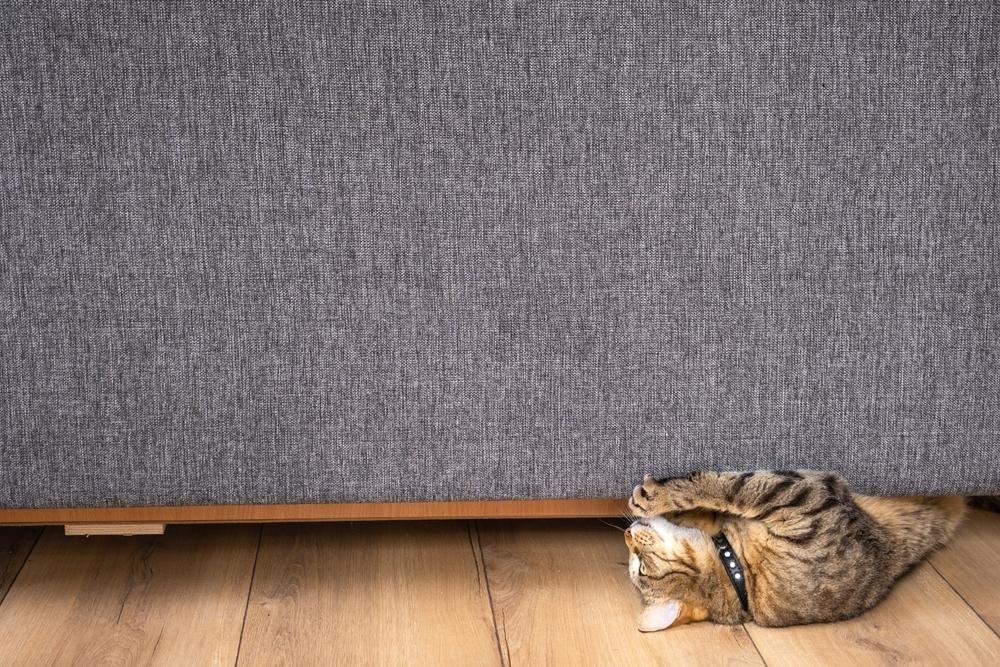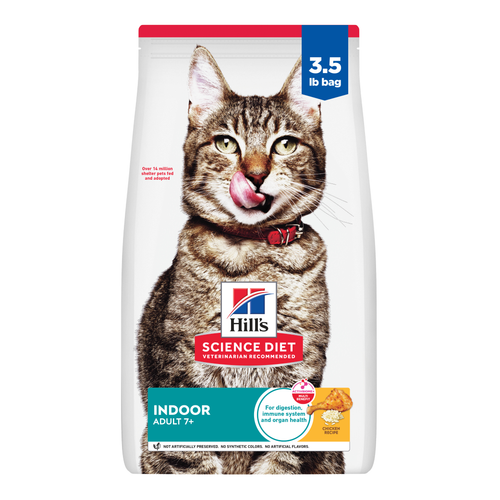

Kittens may not speak our language, but their tiny bodies are full of expression. From twitching ears and playful pounces to soft meows and purrs, there are several ways they clue us in to how they're feeling. If you're wondering "why do kittens purr" or just want to learn more about how your cat communicates, you're in the right place. Learning to read these signals can help strengthen your bond, giving you a way to understand your furry friend during play time, cuddle time and all the moments in between.
Why Do Kittens Purr? Understanding Your Kitten's Sounds
Kittens produce a variety of sounds, each with distinctive meanings. Animal behaviorists use context clues and accompanying body language to determine the purpose of each of these sounds. Remember that cats depend just as much on body language as on vocal cues, so it's important to look at both of these things together to better understand your cat's meaning.
Here are some of the most common sounds kittens make and what they mean.
Happy Sounds
Your kitten may make happy noises when they're getting pets, food or other rewards that make them, well, happy! These include:
Purring
Kittens begin purring shortly after birth. Purring often means contentment, although it doesn't always indicate happiness. Purring loudly is a sign of affection, happiness (some cats purr as they eat) or it may be a request. Scientists have identified differences in purrs, with "food solicitation" purrs including a quieter, higher-pitched meow that most people readily respond to.
Meowing
As your kitten grows up, you'll start to hear distinctive "meows" from them. Kittens may meow when separated from their mother, but adult cats rarely meow at other cats. Most meows are directed at humans, asking them to fill the food bowl, open the door, or pet them. Meow-requests start at a higher pitch, but if ignored, the demands often become louder, longer and lower-pitched.
Trilling/Chirping
Mother cats use this happy sound to call their kittens. Cats and kittens also use this as a sweet greeting, an invitation to a friendly interaction or to ask for their human's attention.
Distressed sounds
Kittens vocalize in several different ways depending on the situation, and the variety may broaden as they get older. In distressing situations, you may see them express themselves by:
Chattering
Cats chatter as an expression of frustration, often when thwarted by watching birds through the window they can't reach. They may also chatter at other prey animals. In their excitement, they can lash out at nearby targets, so avoid direct contact with your chattering cat to keep from an accidental bite.
Snarling/Growling
You'll usually hear your cat hiss and growl during tense encounters with other animals. This happens during both offense (as a preamble to an aggressive attack toward another animal or person) and defense, warning you away out of fear.
Hissing
If you're wondering why kittens hiss, it's usually because they're frightened. A hiss warns you to back off or suffer the consequences of claws and teeth.
Spitting
The explosive sound of a cat spitting is almost like a quick, forceful exhale or a short hiss with extra intensity. It's often paired with an arched back, wide eyes and sometimes a swipe of the paw. This usually happens when something startles the kitten.
Yowling/Shrieking
Yowling or sudden shrieking indicates extreme fear or pain and distress. Prolonged yowling is also seen in breeding-age female cats when they're in heat. Deaf cats and very old cats may also yowl when they can't hear something or are confused.
Understanding Kitten Behavior and Body Language
Cats are very expressive with their body language. Think of body language as the direct message, and vocalization as the emotion behind it. You must take into account both body language and vocalization (if any) for a complete picture of cat communication.
Kitten Tail and Ear Meaning
A cat's tail is an excellent indicator of feelings. A happy kitten will hold their tail straight up with the end tipped over like a tiny wave — adult cats use this as a greeting. A fearful crouching cat wraps the tail tightly around the body, or if standing, may hold it downward in an inverted U-shape (the typical Halloween cat pose). The broad swishing of an adult cat's tail shows annoyance or impatience. If really agitated, the tail will move rapidly from side to side, or thump the ground after the cat falls onto their side — this is clearly threatening behavior, getting all four sets of claws ready to engage. A twitching tail is a sure sign of your kitten's excitement and curiosity.
Cats also use their ears to show how they're feeling. Pricked ears are an indication of curiosity. Ears held erect and inclined forward mean they're relaxed, friendly and interested. Ears turn sideways and flatten like airplane wings when the kitten feels uneasy or frightened. But when a cat's ears turn nearly backwards flat against the head, an aggressive outburst may happen. This is done to keep them out of the way should a fight erupt.
Kitten Fur and Whisker Position
The position of the whiskers and elevation of the fur communicate volumes. Whiskers fan out slightly to the side from each side of the face when happy and relaxed. They'll fan forward with interest, like when hunting or stalking a toy. Cats slick their whiskers back tightly against their face with discomfort or irritation, and in preparation for an aggressive attack.
A calm kitten's fur lies smooth against the body, but it fluffs up with fear or aggression. Called pilo-erection, this makes the cat look bigger and more of a threat, so the scary adversary goes away.

Tips on Communicating with Kittens
Pay Attention to Context
Consider what's happening in the cat's environment. Is there something or somebody new in the home? Is there a stray animal or bird outside the window? These context clues can help you understand why your kitten is acting a certain way.
Listen and Watch for Patterns
Kittens pay very close attention to cause and effect. They meow, you fill the bowl. They bite, you stop petting. Watching for patterns can help you better understand their needs and communicate to them more clearly, as well.
Consult your Veterinarian
Anytime your kitten behaves with extremes of emotion, like routinely expressing distress sounds, or fearful/aggressive body language, it's best to talk to your vet. This may signal a health issue or may indicate you need more professional behavior support.
FAQs
Why do kittens make noise?
Just like humans, kittens may vocalize to show a range of emotions. They also learn to repeat the noise when it gets a desirable response from you. If you wonder, "why is my kitten meowing so much?" it may be because you're (perhaps unintentionally) rewarding the kitten's meowing by filling the food bowl or giving attention. They may repeat the behavior to receive more rewards.
When do kittens purr?
Kittens typically purr when happy, but there are other reasons they may purr, as well, such as when they're anxious or ill. In these situations, they may be trying to self-soothe. Purrs have been shown to speed up the healing of broken bones, so kittens may purr when feeling pain.
Why do kittens show their tummies?
A kitten that rolls over onto their back and stretches out, baring their tummy shows submissiveness and trust in you. The behavior also asks for attention, and cats often use this as a greeting behavior. But beware of touching that sweet tummy. Cats typically won't appreciate tummy rubs like dogs do, and they may respond by grabbing your arm, kicking with their rear paws, or even biting to tell you they don't like it.
Why do kittens rub against you?
Cats use scent as part of their communication strategy. When your kitten rubs against you, they're sharing their scent with you, marking you as important territory. They may do this by rubbing up against your face or rubbing their whole body against you, winding their tail around your ankles.
Why do kittens knead?
Kneading refers to the rhythmic paw-pressing of the cat's front paws on soft surfaces. Animal behaviorists believe it hearkens back to the pleasurable sensation kittens feel as they do this against their mother as they nurse. So when your kitten kneads against your lap, or other soft surfaces, consider it a sign of contentment and happiness.
Why do kittens scratch?
Kittens scratch because clawing feels good. It not only sharpens claws and tones muscles, the scent glands in the paws leave territorial marks important to feline communication.
Why do kittens lick you?
Cats lick themselves and each other as part of self-grooming. This also shares their individual scent so friendly cats can identify each other with this family smell. When you pet your kitten, it feels like being groomed and also shares your scent. Kittens lick you to return the favor as a part of bonding.
Why do kittens bite?
Too much petting and handling can overstimulate some kittens. They quickly learn that biting stops you (or their playmate) from the objectionable behavior, so they resort to biting again and again. But this isn't the only reason — kittens also play-bite during games together, so they may target you while playing.
When do kittens calm down?
Kittens love to play, and play aggression with biting can become explosive by age five months. Play, including aggression, usually slows down and fades by six to nine months. But many cats continue to indulge in "zoomies" every day or so.
Bonding Through Behavior
Getting to know your kitten is an exciting time — one in which you're both learning so much about each other, your behaviors and your communication styles. Understanding the different ways your cat talks to you is a great first step in building that bond. But remember: every cat has their own personality. As you pet, play with, and talk to your cat regularly, you'll develop your own language between each other. In short, more moments together mean a deeper bond where trust and love abound.























